The Navigo pass will cost €88.80 in 2025. What for?
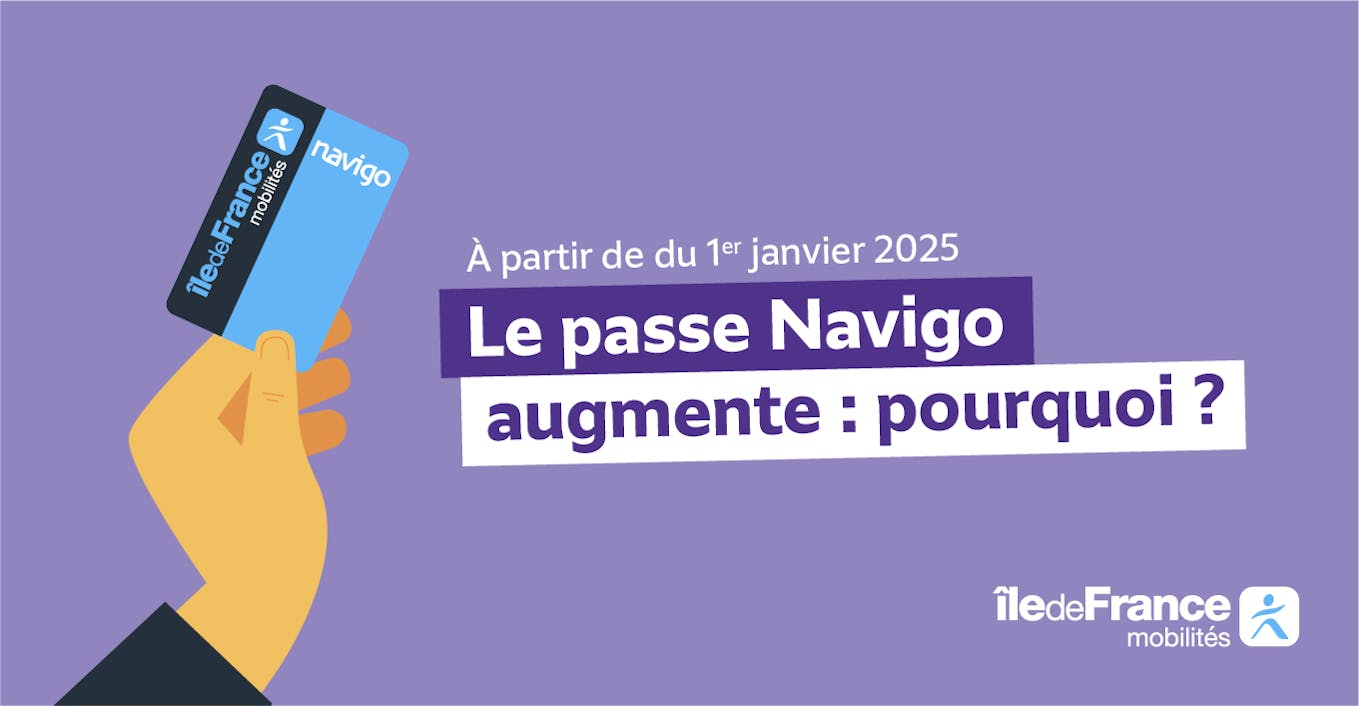
From 1 January 2025, the price of your Navigo pass will increase by €2.40. Let us explain.
Your monthly Navigo season ticket will increase by €2.40 in 2025. But why?
On January 1, 2025, the price of public transport in the Ile-de-France region will change. Your monthly Navigo subscription goes from €86.40 to €88.80.
An increase that corresponds to the price of inflation + 1 point, and which will remain under control for the next eight years thanks to an agreement signed between Île-de-France Mobilités and the State which guarantees an increase capped at the price of inflation + 1 point maximum.
An increase necessary to maintain:
- The operation of transport, carried out by operators with very familiar names (such as SNCF, RATP, Transdev, Keolis or Lacroix-Savac), with whom Île-de-France Mobilités contracts to carry out: the operation and maintenance of lines and vehicles, the modernisation of lines, the safety of passengers and the implementation of various services at stations.
- And the constant investments made to modernize a network, among the densest and largest in the world, and to renew the rolling stock (trains, metros, RER, trams and buses) essential to the mass adoption of public transport in the face of the environmental challenge.
Control of fare increases: Île-de-France Mobilités signs an agreement with the State until 2031
To preserve the purchasing power of Ile-de-France residents as much as possible, Île-de-France Mobilités signed a global agreement with the State in September 2023. This agreement provides new, sustainable resources for the operation of the network and its modernisation for the next eight years.
What are the advantages of the agreement between Île-de-France Mobilités and the State?
- The implementation of a tariff shield until 2031, which controls the price of the annual increase to inflation + 1
- Companies, which benefit greatly from the new regional transport infrastructure, see their fees increase, to preserve the share paid by the passenger.
- Tourists will be asked to contribute with the increase in the tourist tax.
- Local authorities (including the Île-de-France Region and all the departments in the Ile-de-France region) have committed to increasing their contribution over several years.
Good to know: in 2024, the operating budget of Île-de-France Mobilités, the one that allows the network to "run" on a daily basis, amounted to 12.2 billion euros.
2025: Île-de-France Mobilités' network continues to be strengthened
This (controlled) increase in the fares of the Navigo pass helps to finance the operation of a public transport network in the Ile-de-France region that continues to develop.
Thus, in 2025, passengers will be able to enjoy, for example , the C1, the first 100% accessible cable car in Île-de-France , which will connect the cities of Villeneuve-Saint-Georges, Limeil-Brévannes and Valenton from the Créteil - Pointe du Lac metro station on line 8.
Another new feature for 2025 is the commissioning of the Tzen 4. More comfortable, more efficient and more environmentally friendly, this 100% electric bus, which will run largely on dedicated tracks, will replace line 402 over 14 km between Viry-Châtillon and the Corbeil-Essonnes RER station, the busiest section of the outer suburbs.
In 2025, modern rolling stock will allow for more comfortable and reliable journeys. Among them, the MF19, a new-generation metro, which will equip line 10 in 2025 before gradually arriving on lines 3, 3bis, 7, 7bis, 8, 12 and 13, with 100% of metro lines equipped with new metros by 2033.
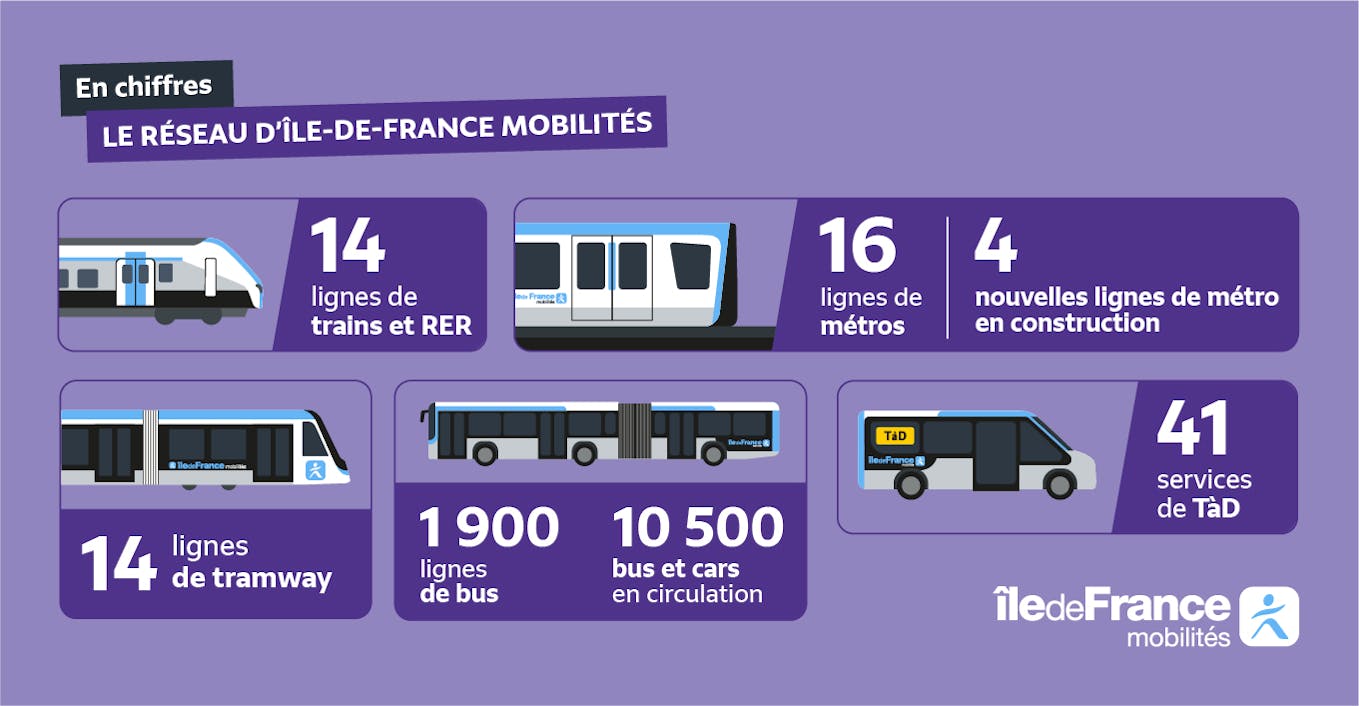
The Île-de-France Mobilités network includes 14 train and RER lines, 16 metro lines and 4 new metro lines under construction, 14 tram lines, 1900 bus lines and 10,500 buses and coaches in circulation as well as 41 Transport on demand services.
By the way, do you know the real price of the Navigo subscription?
The real cost of the monthly Navigo subscription, without aid, subsidies or external funding other than that of the user, is 274.06 euros instead of the 88.80 €/month charged to Ile-de-France residents.
But how is transport financed in Île-de-France?
In 2025, transport subscriptions for Ile-de-France Mobilités residents and the sale of single tickets will account for 32% of Île-de- Mobilités' total operating budget.
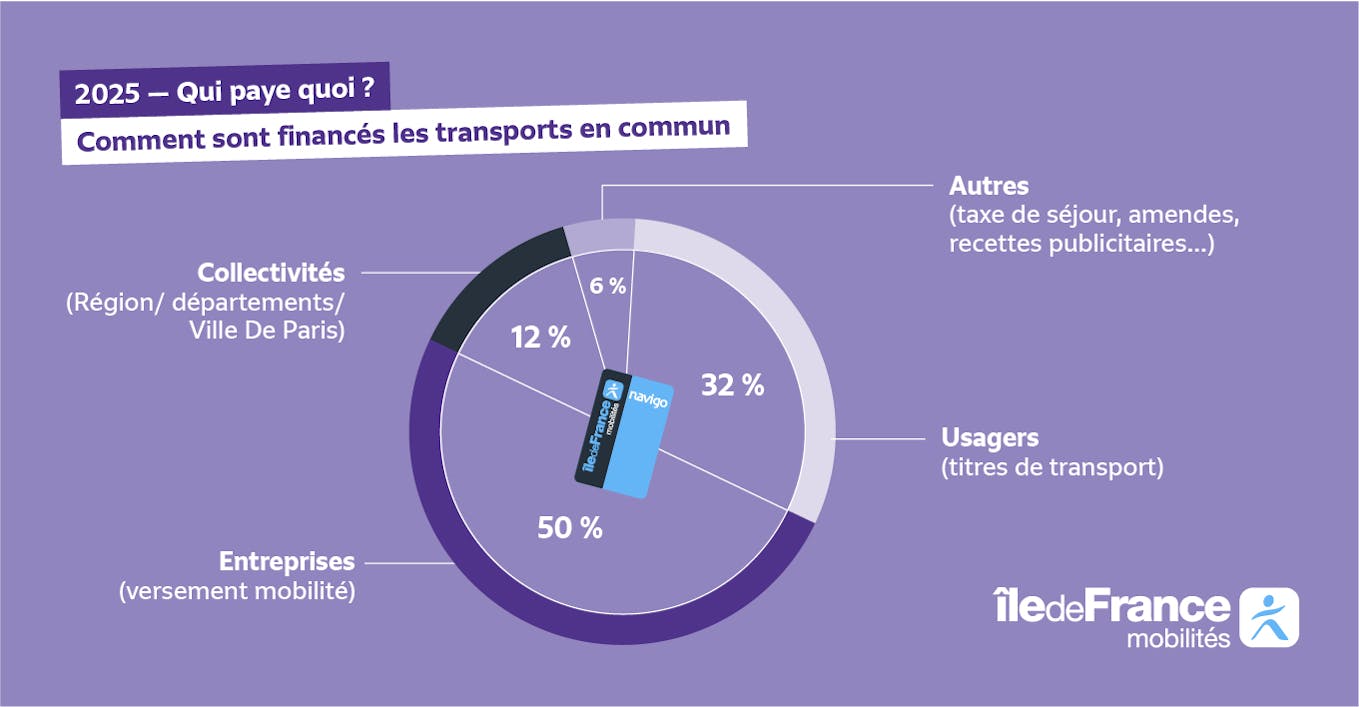
Distribution of Île-de-France Mobilités' funding: 50% by employers, 32% by users, 12% by public competitions and 6% by advertising and other additional sources of income.
In fact, the budget and financial balance of the Ile-de-France network depend, in large part, on the investment of several players. Check them out.
Ile-de-France companies: 50%
Companies with more than 10 employees based in the Île-de-France region are the main contributors to the Île-de-France Mobilités budget. They represent 50% of the total funding of the transport authority. How do they participate in the functioning of the network?
- The mobility payment : a contribution due by employers (private and public), to finance transport and mobility services.
- Reimbursement : employers are obliged to reimburse up to 50% of their employees' transport tickets, and can even go up to 75%.
Travellers: 32%
Passengers are the second source of funding for public transport in the Ile-de-France region via the purchase of various subscriptions (Navigo Annual, Month, Junior and Senior, Imagine R) and T+ tickets. They make it possible to finance the network up to 32%.
Public competitions: 12%
What are "public competitions"? These are financial aids awarded in the form of contributions, social actions, donations, compensation or subsidies by public institutions. But who are we talking about? The Île-de-France Region, the City of Paris and the Ile-de-France departments. Together, they contribute 12% of the annual budget.
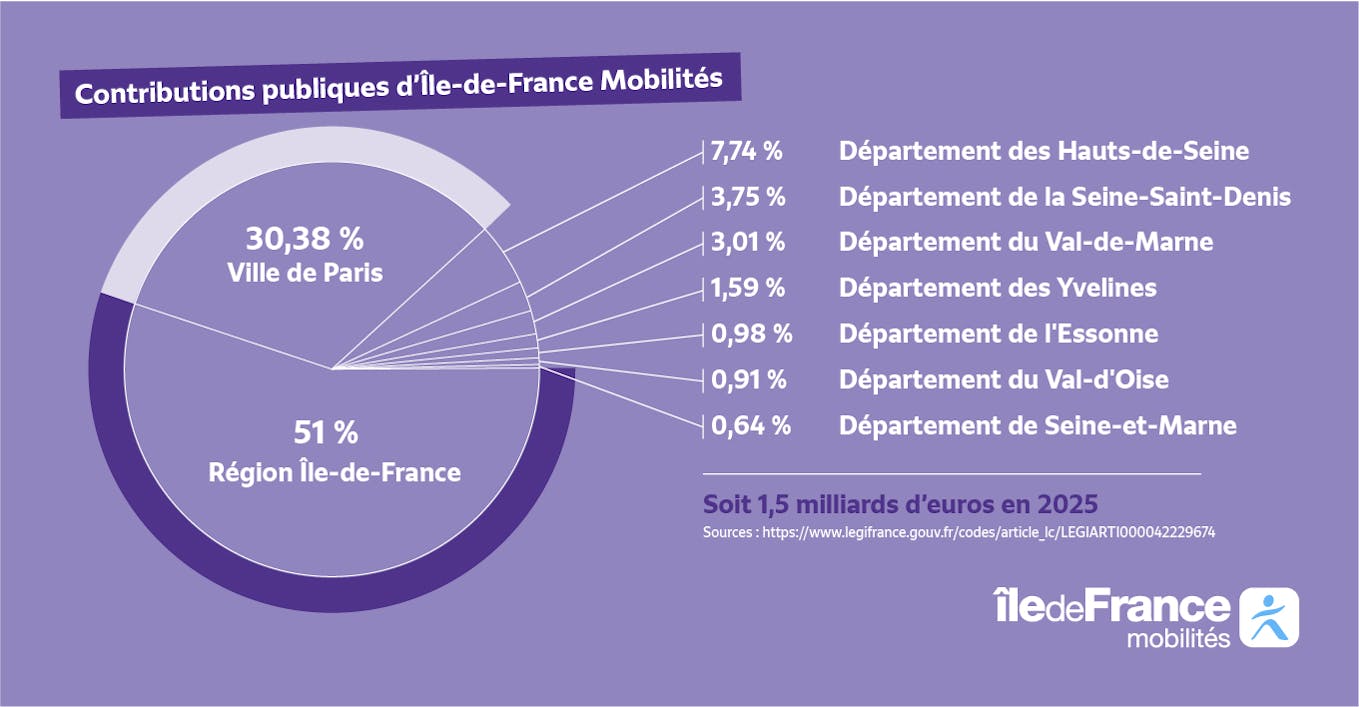
Breakdown of the share of public contributions in the financing of Île-de-France Mobilités: 30.38% by the City of Paris, 51% by the Île-de-France Region, 7.74% by the Hauts-de-Seine Department, 3.75% by the Seine-Saint-Denis Department, 3.01% by the Val-de-Marne Department, 1.59% by the Yvelines Department, 0.98% by the Essonne Department, 0.91% by the Val-d'Oise Department and 0.64% by the Seine-et-Marne Department.
The rest: 6%
A final part, about 6%, comes from the revenue generated by the advertisements you see displayed on the platforms, in your transport or at bus stops, fines and various taxes.
Financing a network that is set to double by 2031
The long-term financing of Île-de-France Mobilités will support the development, equipment and maintenance of a rapidly expanding network, which is expected to double by 2031 with 300 km of new lines :
The metro arrives in the inner and outer suburbs
From 2026 until 2030, the new metro lines 15, 16, 17 and 18, a real rail ring around Paris and interconnected to the existing transport network, will be gradually put into service in Île-de-France.
Extended lines by 2030
- The T1 tramway will continue its journey to the east between Noisy-le-Sec and Val-de-Fontenay before connecting, to the west, Colombes to Rueil-Malmaison
- The T7 tramway will continue its journey in Essonne between Athis-Mons and Juvisy with 6 new stations
- The T8 tramway will connect Saint-Denis Porte de Paris to the Rosa-Parks train station via Aubervilliers and the 18th and 19th arrondissements
- The T10 tramway will be extended between Jardin Parisien and Clamart station with 3 new stations
- The T13 tramway will extend its route by 10 km and 4 stations between Saint-Germain-en-Laye and Achères
- The RER E, after a first extension to Nanterre-la Folie in 2024, will continue its route to Mantes-la-Jolie
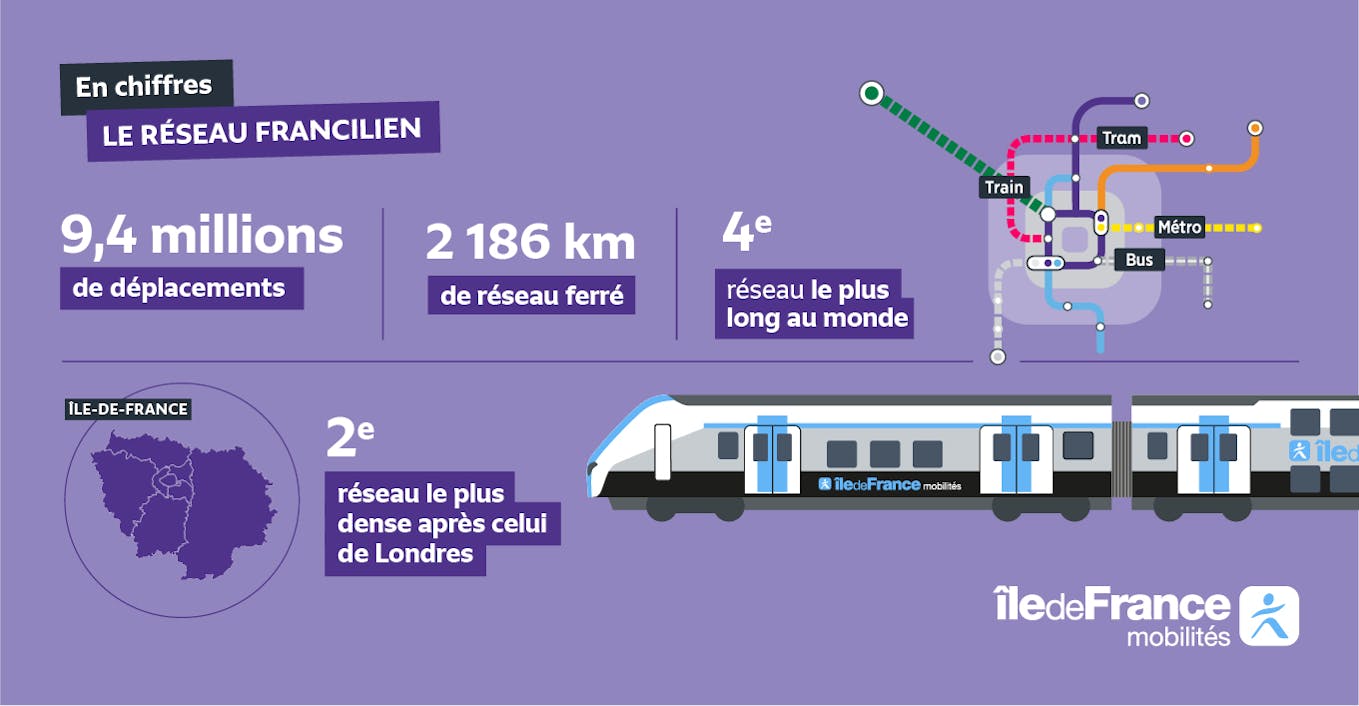
The Ile-de-France network in a few key figures, 9.4 million trips per day, 2122 km of rail network, 4th longest network in the world, 2nd busiest network after Tokyo.
Financing as a cornerstone of the social role of transport
It is this multifaceted economic ecosystem that allows Île-de-France Mobilités to offer preferential rates and financial aid (such as the Solidarity Transport Pricing, the Free Youth Integration Package or reduced single ticket fares, for example), thus giving access to public transport to as many people as possible and allowing passengers to pay only part of their ticket.
Transport financing is therefore a cornerstone of the transport vision wanted by Île-de-France Mobilités. Fair, accessible and, above all, scalable mobility.